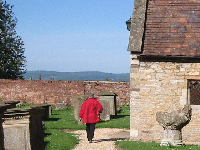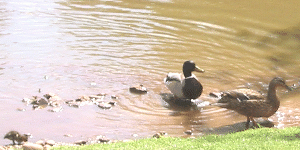Forest Edge Group, Anglican Church, Gloucestershire, UK
St Andrews Churcham with Birdwood
Sunday Services ChurchamFirst week 9.30am HC, Second week 6pm, Third week 11am HC, Fourth week 10am Family Service
 Churcham was called Hamme when it was recorded in the Domesday Book. It became Churcham when the manor was given to the Abbey of Gloucester in recompence for a battle where some monks were killed.
Churcham was called Hamme when it was recorded in the Domesday Book. It became Churcham when the manor was given to the Abbey of Gloucester in recompence for a battle where some monks were killed.The Nave, Chancel arch and lower part of the tower stonework are remnants of the original pre-Norman work. In 2003, Churcham, a few miles east of Huntley, is a farming community with a Primary School on the Main Rd. The Parish was joined to Huntley in October 2002, and the five parishes are called 'The Forest Edge Group' of churches.
The lych gate is very impressive, with the early morning sunlight shining on the tower and spire. | |
 On 8 Aug 2008 the memorial to Henry Hook was re-instated in the Churcham churchyard. The new granite chippings on the grave were kindly donated by Allstone of Gloucester.
On 8 Aug 2008 the memorial to Henry Hook was re-instated in the Churcham churchyard. The new granite chippings on the grave were kindly donated by Allstone of Gloucester.Henry Hook was born in Bulley and came to fame at the Battle of Rourke’s Drift, South Africa. After the battle he was awarded the Victoria Cross for his bravery. He died in 1905 in Gloucester and was buried in Churcham. His wife Ada is buried by his side.  The Gloucester Co-op Funeralcare was contacted to see if they would be willing to help with the Hook memorial and, after satisfying them that the Church owned the memorial (it is well documented that the vicar of Churcham in 1905 started a public subscription for a memorial and raised the sum of £20–8s–7d), the Co-op kindly agreed to restore it.
The Gloucester Co-op Funeralcare was contacted to see if they would be willing to help with the Hook memorial and, after satisfying them that the Church owned the memorial (it is well documented that the vicar of Churcham in 1905 started a public subscription for a memorial and raised the sum of £20–8s–7d), the Co-op kindly agreed to restore it.
Wheels were set in motion and The Royal Regiment of Wales Museum at Brecon were contacted to obtain the correct inscription for the stone. On the 28th July this year Highworth Memorials (a Co-op company) collected the memorial and cleaned and re-lettered it.
See Hook-VC and also for Henry's own account of what happened at Rorke's Drift, 22nd and 23rd of January, 1879, his share in the Action. He received his VC from Sir Garnet Wolseley, GOC South Africa at Rorke's Drift on 3 August 1879. | |

 The south wall, outside the chancel, showing the narrow door, and the different sizes of the stones used.
The south wall, outside the chancel, showing the narrow door, and the different sizes of the stones used.Notice Mary at the porch containing the main entry door, also the remnant of the decommissioned Font. | |
 The old font was broken on 26 Oct 1675 when the thatch roof of the church caught fire, and fell into the nave. Cleanup included a new font placed beside the stump of the original. The old font was broken on 26 Oct 1675 when the thatch roof of the church caught fire, and fell into the nave. Cleanup included a new font placed beside the stump of the original.
 The present spire and nave roof were built after the 1875 fire.
The present spire and nave roof were built after the 1875 fire.In 1914 the maintenance work on the interior of the Nave uncovered this Piscina - a niche in the church with a small water drain into which the Priest empties any water used. It is on the south wall, close to the sanctuary and beside the Pulpit. | |
 Stonework of old Norman windows is visible on the outside walls. A small carved stone over the outside of the North Door is older than the church, and believed to be British.
Stonework of old Norman windows is visible on the outside walls. A small carved stone over the outside of the North Door is older than the church, and believed to be British.St Andrews is surrounded by farms, and next to a large duck pond. Only one from the previous clutch eluded the cats, so the parents are wary with 13 new ducklings to watch. | |
| Recorded by Rev George Charles Hall Inducted August 1837 into the Vicarage of Churcham with Bulley annexed.
On 12 July 1849 the Foundation Stone of the Church of the Holy Innocents was laid at Highnam by Charles Clinton Parry, eldest son of Thomas Gambier Parry Esquire of Highnam Court. |
|
If you enjoy this page, please Email me. © |
 The film, which also starred Michael Caine, showed the battle by about 150 British soldiers, most from the 24th Regiment of Foot (later the South Wales Borderers), against 4,000 Zulu warriors Rorke's Drift in South Africa. With Private John Williams, Private Hook, then aged 28, fought off fighters to bring eight patients to safety.
The film, which also starred Michael Caine, showed the battle by about 150 British soldiers, most from the 24th Regiment of Foot (later the South Wales Borderers), against 4,000 Zulu warriors Rorke's Drift in South Africa. With Private John Williams, Private Hook, then aged 28, fought off fighters to bring eight patients to safety.